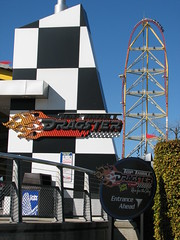 Cedar Point – Sandusky, Ohio
Cedar Point – Sandusky, Ohio
“Keep arms down, head back, and hold on.”
That’s the best part of Top Thrill Dragster. Nothing else along the ride can even compare. Accelerating to 120 miles per hour in four seconds? No problem. Ascending straight up a tower 420 feet in the air? Nothing to it. A 400 foot long vertical freefall back down through a 270 degree spiral? Piece of cake. Sitting perfectly still on the launch track, listening to the safety recording, waiting for the anti-rollback brakes to drop and the train to roll back an inch to engage in the catch dog? That’s where the genuine thrills are found. Much as they say it’s more erotic to wonder if you’re about to be kissed than it is to be kissed, so the same applies here. It’s more thrilling to contemplate riding Top Thrill Dragster than it actually is to experience it. For a coaster with the tallest and fastest statistics when it was built, it relies on a surprisingly large degree of psychology for it to work.
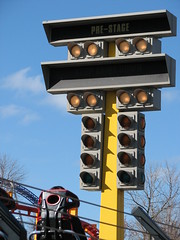 This might sound slightly counter-intuitive. Psychology can maybe help make a coaster that isn’t the biggest and meanest out there seem scarier than it otherwise would be. There’s certainly a lot involved in the anticipation of the ride, and that only helps make it all the more effective. But it would seem to most people that once they’re being catapulted to 120 miles per hour and thrown 420 feet in the air, they’re screaming not because psychological tricks are being played on them but because the ride is terrifying, period. Not just as a thing we perceive, but as a thing-in-itself.
This might sound slightly counter-intuitive. Psychology can maybe help make a coaster that isn’t the biggest and meanest out there seem scarier than it otherwise would be. There’s certainly a lot involved in the anticipation of the ride, and that only helps make it all the more effective. But it would seem to most people that once they’re being catapulted to 120 miles per hour and thrown 420 feet in the air, they’re screaming not because psychological tricks are being played on them but because the ride is terrifying, period. Not just as a thing we perceive, but as a thing-in-itself.
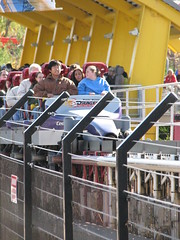 But take a moment to analyze what it is that one could properly call objective terror rather than subjective (or psychological) terror. First of all we should realize that all terror is, by definition, subjective. Chunks of steel mass, no matter how enormous, can’t be terrifying unless there is a sentient being around to be terrified by it. But even
But take a moment to analyze what it is that one could properly call objective terror rather than subjective (or psychological) terror. First of all we should realize that all terror is, by definition, subjective. Chunks of steel mass, no matter how enormous, can’t be terrifying unless there is a sentient being around to be terrified by it. But even 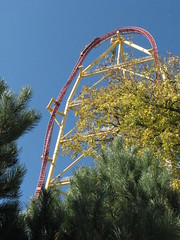 still, that’s just a technicality, right? The emotions experienced while riding Top Thrill Dragster are all subjective but they are in response to this thing-in-itself which, through logical, rational analysis, can be determined to ontologically have qualities that make it more intimidating than nearly any other roller coaster out there. That’s true of any aesthetic judgment, right? Yes, as humans we subjectively experience a sensation of ‘redness’ and therefore find it pleasurable or not, but we still assume that there is something objectively out there that causes that perception, even if it’s in the form of quantum physics and molecular structures causing light particles to bend to a certain wavelength that, upon hitting our optical nerves, causes the mind to register it as ‘red’. If we want to establish Top Thrill Dragster as a genuine thrill device rather than an overblown use of $25 million just to make us think it’s scary when it’s actually not, that sounds like a promising argument (albeit pretentious, but that’s par
still, that’s just a technicality, right? The emotions experienced while riding Top Thrill Dragster are all subjective but they are in response to this thing-in-itself which, through logical, rational analysis, can be determined to ontologically have qualities that make it more intimidating than nearly any other roller coaster out there. That’s true of any aesthetic judgment, right? Yes, as humans we subjectively experience a sensation of ‘redness’ and therefore find it pleasurable or not, but we still assume that there is something objectively out there that causes that perception, even if it’s in the form of quantum physics and molecular structures causing light particles to bend to a certain wavelength that, upon hitting our optical nerves, causes the mind to register it as ‘red’. If we want to establish Top Thrill Dragster as a genuine thrill device rather than an overblown use of $25 million just to make us think it’s scary when it’s actually not, that sounds like a promising argument (albeit pretentious, but that’s par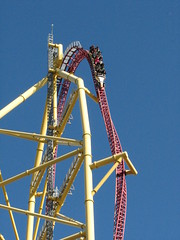 for the course on this website). Now we must ask, what are these ontological qualities we perceive as genuinely terrifying?
for the course on this website). Now we must ask, what are these ontological qualities we perceive as genuinely terrifying?
The incredible height and speed are the first things we want to look at. 120 miles per hour in four seconds and then up a 90 degree, 420 foot tall tower are not numbers to be scoffed at. But that’s a problem, these are only numbers. You can’t actually ‘feel’ speed or height; if we could then a twelve hour flight from Chicago, Illinois to Rome, Italy would be way more exciting. So then maybe we should conclude that its accelerational motion we feel, and that’s what makes it exciting? Top Thrill Dragster certainly has plenty of that, correct? Let’s see:
We’re waiting for the Christmas tree lights to count down our launch. The hydraulic motors start reeling in the cable, the catch-dog positioned along it thrusting the entire 5.3 ton train forward. Not only is the forward accelerational force very strong, but it hits very suddenly (i.e. the change in acceleration very abruptly shifts from zero to the constant force felt down the launch track), causing everyone’s back to snap flat against the seat, and then holding us there for the four seconds down the launch track. An interesting side-effect is that after a second or two our bodies start to acclimate to this constant accelerational force so that once the train gets to the end of the launch strip, many people will report a sudden slow-down in speed. That’s actually not due to any massive deceleration (although the wind resistance is a much greater factor here than on most other coasters) but just from the removal of the accelerational force.
Not only is the forward accelerational force very strong, but it hits very suddenly (i.e. the change in acceleration very abruptly shifts from zero to the constant force felt down the launch track), causing everyone’s back to snap flat against the seat, and then holding us there for the four seconds down the launch track. An interesting side-effect is that after a second or two our bodies start to acclimate to this constant accelerational force so that once the train gets to the end of the launch strip, many people will report a sudden slow-down in speed. That’s actually not due to any massive deceleration (although the wind resistance is a much greater factor here than on most other coasters) but just from the removal of the accelerational force.
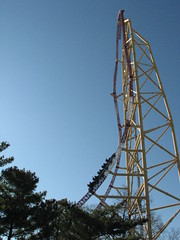 The pull up into the tower is the most forceful part of the ride, the positive g-forces frequently capable of bringing enthusiasts’ arms down, at least those who weren’t expecting or preparing for this force. The way up the tower can only be felt as a light push against the back since we’re mostly following the same freefall path as the train would naturally take, along with some minor rotational forces on the twist up. Cresting the top of the tower can produce very different experiences depending on the launch. Sometimes it barely makes it over, in which one will still feel some ejector airtime on the curve from and to 90 degrees on either side, as is physically required under the dynamic conditions. At times when it’s launching at full speed, the airtime is some of the best you will ever find on the planet, at least for a single, sustained moment’s worth. As mentioned, the physical
The pull up into the tower is the most forceful part of the ride, the positive g-forces frequently capable of bringing enthusiasts’ arms down, at least those who weren’t expecting or preparing for this force. The way up the tower can only be felt as a light push against the back since we’re mostly following the same freefall path as the train would naturally take, along with some minor rotational forces on the twist up. Cresting the top of the tower can produce very different experiences depending on the launch. Sometimes it barely makes it over, in which one will still feel some ejector airtime on the curve from and to 90 degrees on either side, as is physically required under the dynamic conditions. At times when it’s launching at full speed, the airtime is some of the best you will ever find on the planet, at least for a single, sustained moment’s worth. As mentioned, the physical 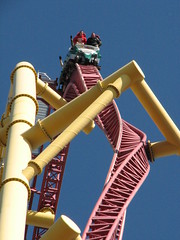 requirements of such shaping ensure that on the parts of the curve nearing 90 degrees will be the most intense because not only is the train traveling at its fastest along these points in the curvature but the upward centrifugal force no longer has the pull of gravity acting in opposition to it. The way down is in freefall, so again we can’t really ‘feel’ very much here, although the rotational forces around our forward axis can be rather fast and produce some interesting dynamics, especially given the unusual context. The pullout of the tower also produces more positive g-forces, but not nearly as strong as the way in due to the loss from wind resistance. Actually one of the most forcefully powerful sections of the ride comes on the final brake run, the deceleration throws everyone forward into their restraint and holds them there for several seconds until it comes to a final halt. In terms of forces it is actually more intense than the initial launch, mostly because of the position we’re in isn’t able to distribute the forces across our body as effectively.
requirements of such shaping ensure that on the parts of the curve nearing 90 degrees will be the most intense because not only is the train traveling at its fastest along these points in the curvature but the upward centrifugal force no longer has the pull of gravity acting in opposition to it. The way down is in freefall, so again we can’t really ‘feel’ very much here, although the rotational forces around our forward axis can be rather fast and produce some interesting dynamics, especially given the unusual context. The pullout of the tower also produces more positive g-forces, but not nearly as strong as the way in due to the loss from wind resistance. Actually one of the most forcefully powerful sections of the ride comes on the final brake run, the deceleration throws everyone forward into their restraint and holds them there for several seconds until it comes to a final halt. In terms of forces it is actually more intense than the initial launch, mostly because of the position we’re in isn’t able to distribute the forces across our body as effectively.
 Now, imagine this entire experience of just forces taking place in an empty, black void. Are we very thrilled? Not really; the forces are sort of strong, but constant, and there’s nothing that could be labeled as ‘dangerously forceful’ or even ‘unexpected’ that should induce in us any emotions anywhere near what we actually experience from the ride. But perhaps that’s fairly obvious to most readers. “Of course it’s not just the forces, but the context of them!” There’s the wind in your face, watching scenery peel by in a blur, looking at the world from 400 feet in the air, and just the pure thrill of knowing how rapidly we’re moving through space…
Now, imagine this entire experience of just forces taking place in an empty, black void. Are we very thrilled? Not really; the forces are sort of strong, but constant, and there’s nothing that could be labeled as ‘dangerously forceful’ or even ‘unexpected’ that should induce in us any emotions anywhere near what we actually experience from the ride. But perhaps that’s fairly obvious to most readers. “Of course it’s not just the forces, but the context of them!” There’s the wind in your face, watching scenery peel by in a blur, looking at the world from 400 feet in the air, and just the pure thrill of knowing how rapidly we’re moving through space…
But wait a minute, this puts us back to where we started, with a roller coaster that physically isn’t all that intense,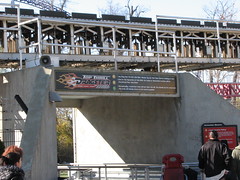 but becomes terrifying only through an entirely subjective perspective. This would then probably make sitting still, watching the Christmas tree lights count down, waiting to launch, the most (if not only) terrifying moment of the entire ride for most people, because once we’re launching forward the tension from the anticipation has been released, and the rest of the ride that follows is only as scary as we subjectively perceive it to be rather than because it actually is. It’s only after having spent the last hour thinking about how scary 120 miles per hour and 420 feet must be, that when we actually get to experience it, it becomes a self-fulfilling prophecy all entirely based on psychology. I one time rode it with a friend who, right as we were rolling up to the launch zone, I asked if he was at all nervous, and he answered flatly, “no”. When we got back he
but becomes terrifying only through an entirely subjective perspective. This would then probably make sitting still, watching the Christmas tree lights count down, waiting to launch, the most (if not only) terrifying moment of the entire ride for most people, because once we’re launching forward the tension from the anticipation has been released, and the rest of the ride that follows is only as scary as we subjectively perceive it to be rather than because it actually is. It’s only after having spent the last hour thinking about how scary 120 miles per hour and 420 feet must be, that when we actually get to experience it, it becomes a self-fulfilling prophecy all entirely based on psychology. I one time rode it with a friend who, right as we were rolling up to the launch zone, I asked if he was at all nervous, and he answered flatly, “no”. When we got back he 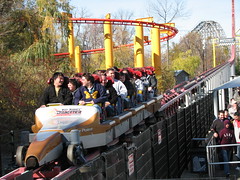 reported to be much underwhelmed and the only part he really liked was on the pull-up when the positive g’s forced his arms down, and a little bit of the airtime on the way down but even that he said could have been a lot better given the scale. At first I thought he was exaggerating but after thinking about it I realized his assessment really was completely accurate, at least for anyone that didn’t leave the station already slightly nervous.
reported to be much underwhelmed and the only part he really liked was on the pull-up when the positive g’s forced his arms down, and a little bit of the airtime on the way down but even that he said could have been a lot better given the scale. At first I thought he was exaggerating but after thinking about it I realized his assessment really was completely accurate, at least for anyone that didn’t leave the station already slightly nervous.
This isn’t to demean Top Thrill Dragster in the slightest. It’s a method that works, as evidenced by the 99% of riders that return to the station breathless and hands trembling. What’s more, this argument that the thrill of the ride is purely subjective can be applied to every roller coaster no matter how big or small.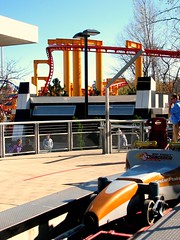 It’s rooted in Immanuel Kant’s Critique of Judgment, particularly on aesthetic judgment and the sublime. For Kant, there was no such thing as an objective judgment, everything we know about the external world must be transmitted through our sense organs and interpreted by our brain, therefore making any aesthetic judgments reflective of the subject looking at it rather than of the object itself. The sublime refers to those seemingly boundless objects that leave one in awe at the sheer scope of it. Examples are normally natural: a mountain, Niagara Falls, the Grand Canyon; but they could also be
It’s rooted in Immanuel Kant’s Critique of Judgment, particularly on aesthetic judgment and the sublime. For Kant, there was no such thing as an objective judgment, everything we know about the external world must be transmitted through our sense organs and interpreted by our brain, therefore making any aesthetic judgments reflective of the subject looking at it rather than of the object itself. The sublime refers to those seemingly boundless objects that leave one in awe at the sheer scope of it. Examples are normally natural: a mountain, Niagara Falls, the Grand Canyon; but they could also be 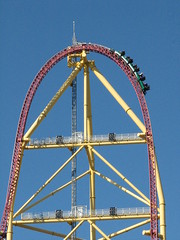 man-made, such as St. Peter’s Square, the Egyptian pyramids… or Top Thrill Dragster. Again, the important feature to remember is that an object such as Top Thrill Dragster is not sublime in-and-of-itself, but only when a sentient subject compares a ride of such incalculable mass to themselves and declares it to be sublime. What specifically makes a coaster sublime is the failure of the subject to be able to mathematically comprehend the object; one can logically conclude that the ride is 420 feet tall or 120 miles per hour, but these numbers are so great that they cannot imagine or understand it in their head at once. Therefore one is left in awe, not because of Top Thrill Dragster itself, but because of the subject’s self-reflexive realization of just how finite their own sensibilities are, and with that the realization that an object of such magnitude has the capability to destroy them.
man-made, such as St. Peter’s Square, the Egyptian pyramids… or Top Thrill Dragster. Again, the important feature to remember is that an object such as Top Thrill Dragster is not sublime in-and-of-itself, but only when a sentient subject compares a ride of such incalculable mass to themselves and declares it to be sublime. What specifically makes a coaster sublime is the failure of the subject to be able to mathematically comprehend the object; one can logically conclude that the ride is 420 feet tall or 120 miles per hour, but these numbers are so great that they cannot imagine or understand it in their head at once. Therefore one is left in awe, not because of Top Thrill Dragster itself, but because of the subject’s self-reflexive realization of just how finite their own sensibilities are, and with that the realization that an object of such magnitude has the capability to destroy them.
This all occurs while waiting on the launch track, when one’s intellectual faculties are still able to make such judgments. As a philosopher I suppose it is natural that I would call this ‘waiting and thinking’ part of the experience my favorite part of the ride, because it engages more with the ego and superego. But then the bottom countdown lights turn green and the rationalist subject’s mind is transfigured into a mass of pure id for the next sixteen seconds of their cognitive existence.
Aww, that thrust feels like orgasm, I don’t know what my response should be, am I allowed to enjoy this?
Maybe I should scream, that’s what I expect of me and I’ll not feel so guilty.
Wait, I can’t breathe! they can’t take my air away that’s my air!
what’s wrong with me? i cant see any thing, im just moving through everything
i dont know what this means, am i going to die?
im almost at the end, im going to die in a second this is awesome!!!
this vibration is all inside of me, soooo good, i cant see anything anymore alright death here i come!!!!!!
WAIT im slowing down? not fair i was ready to die but i guess existence is still pretty good
someones punching me in the gut and holding my arms down. i want to hit them but i cant see them grr
samla mammas manna im going straight up into the sky i knew i was going to die!
everythings so big and im so small i wish everything could become only myself
i can breathe again, I can leave my seat, I’m free and alive!
Okay, I can think again. Wow, look at that view. Everything is so real up here! I really don’t want to die, I want to enjoy my existence forever but I know I only have a couple seconds left before we going back down. Try to enjoy this rush of external reality flooding my senses for a single instantaneous moment before we go back down and that thing causes me to close back into myself.
Shit. that is a long ways down.
im spinning and falling and these yellow things look like they want to kill me. i know theyre supposed to let me live but how can i be sure of that? i cant fight it, so maybe death is the only way to guarantee survival.
i think its almost over, i dont know i cant see anything again. somethings pulling on my stomach am i hungry?
alright im back on the ground but im not stopping when am i going to stop i want to go home now.
ow im being punched again, where is it, wait, this is slowing down, I made it, it’s over!
That was insane, but I feel so good to be alive, I loved it! What was all of that I was thinking while on it, I’m already starting to forget? I don’t know, I think it had something to do with Immanuel Kant and the sublime, or is that just my superego taking over again? Whatever, I think that’s good material for my website so I’ll use it. Hopefully I don’t have to deal with too much stacking on the unload platform, once I get off I should probably get something to eat at the Happy Friar and then go over and do Maverick, I hope the wait isn’t too long…
 So much for Kant’s theories of aesthetic judgment. In fact, what we may have witnessed is potentially quite revolutionary and could refute my thesis that takes the Kantian argument that Top Thrill Dragster’s thrill is purely subjective. The general assumption in Kant’s work is that while making an aesthetic judgment, one’s rational faculties operate independently of any external object (that’s precisely what makes it subjective rather than objective). What happens on the roller coaster is they become so overwhelmed with sensation (while consequently receiving a boost of adrenaline and other natural responses that automatically respond to these external conditions independent of the brain’s cognitions) that this external object becomes the initial cause that directly alters the way the mind
So much for Kant’s theories of aesthetic judgment. In fact, what we may have witnessed is potentially quite revolutionary and could refute my thesis that takes the Kantian argument that Top Thrill Dragster’s thrill is purely subjective. The general assumption in Kant’s work is that while making an aesthetic judgment, one’s rational faculties operate independently of any external object (that’s precisely what makes it subjective rather than objective). What happens on the roller coaster is they become so overwhelmed with sensation (while consequently receiving a boost of adrenaline and other natural responses that automatically respond to these external conditions independent of the brain’s cognitions) that this external object becomes the initial cause that directly alters the way the mind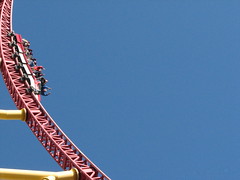 perceives it. We now have a case of an aesthetic judgment that is in some ways objective. Top Thrill Dragster is thrilling because the ride itself is thrilling, not just because we subjectively perceive it to be. Whether or not this represents a fundamental assault to Kant’s theories or is merely an incidental circumstance (or if I completely butchered and misrepresented Kant’s work altogether, an entirely possible event given my aesthetics professor this semester isn’t much more of an intellectual resource than Wikipedia) I will leave to the discussion box below. In the meantime, enjoy a front row point-of-view video:
perceives it. We now have a case of an aesthetic judgment that is in some ways objective. Top Thrill Dragster is thrilling because the ride itself is thrilling, not just because we subjectively perceive it to be. Whether or not this represents a fundamental assault to Kant’s theories or is merely an incidental circumstance (or if I completely butchered and misrepresented Kant’s work altogether, an entirely possible event given my aesthetics professor this semester isn’t much more of an intellectual resource than Wikipedia) I will leave to the discussion box below. In the meantime, enjoy a front row point-of-view video:
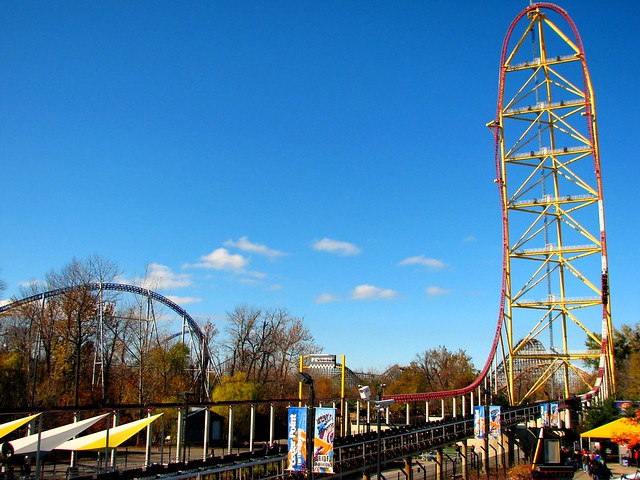



Comments